—Dark swimming pools and the common risks that accompany them
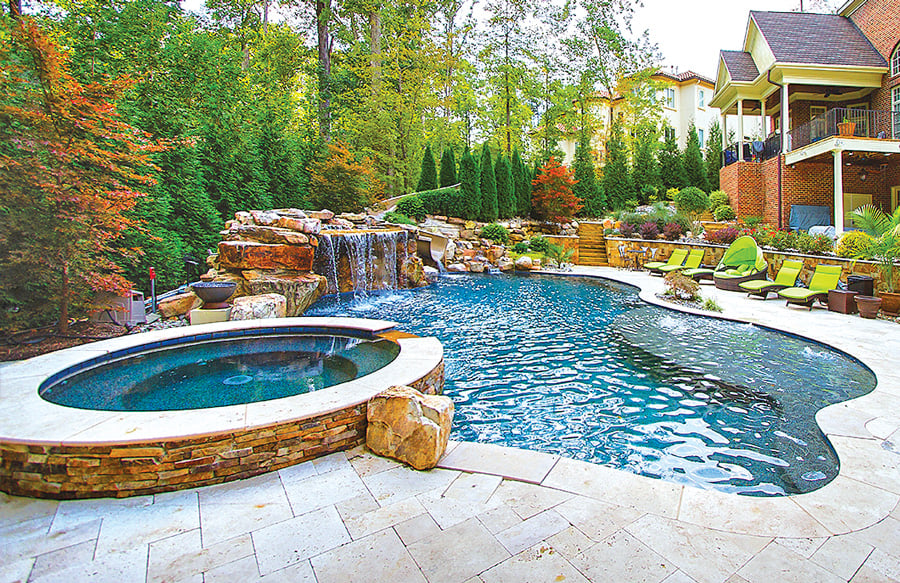
Let’s call a spade a spade: Black-bottom swimming pools come with an array of perils.
Ask someone who chose black pool plaster for their backyard resort about their experience.
You may hear about their initial excitement over the beauty of the brand-new pool—immediately followed by a tale of woes that crush some of the joy of pool ownership.
What makes a black, deep grey, or dark blue pool finish such a burden?
The primary reason is how vulnerable this darkly colored interior is to a myriad of maintenance factors that can seriously mar its appearance.
A secondary factor that makes a dark finish less than ideal relates to the marketability of your home should you sell in the future.
Going dark in a new pool or remodel
To begin, let’s consider a basic question: Why would someone want a black-bottom pool in the first place?
Driving the attraction to such an intense color choice is about the unique appearance it creates. Certainly, a deep-colored finish can imbue a certain level of sophistication and visual drama to the poolscape.
In particular, a black, dark blue, or deep grey interior is aesthetically well-suited for a tropical, lagoon-style pool.
Another reason is that some people find the look of dark water more inviting than the shimmering appearance of water in a white plaster pool.
But in the real world, this high-concept design color benefit may not be worth the possible pitfalls. Let’s look at the plethora of reasons why a black-bottom pool can be something of a treacherous option.
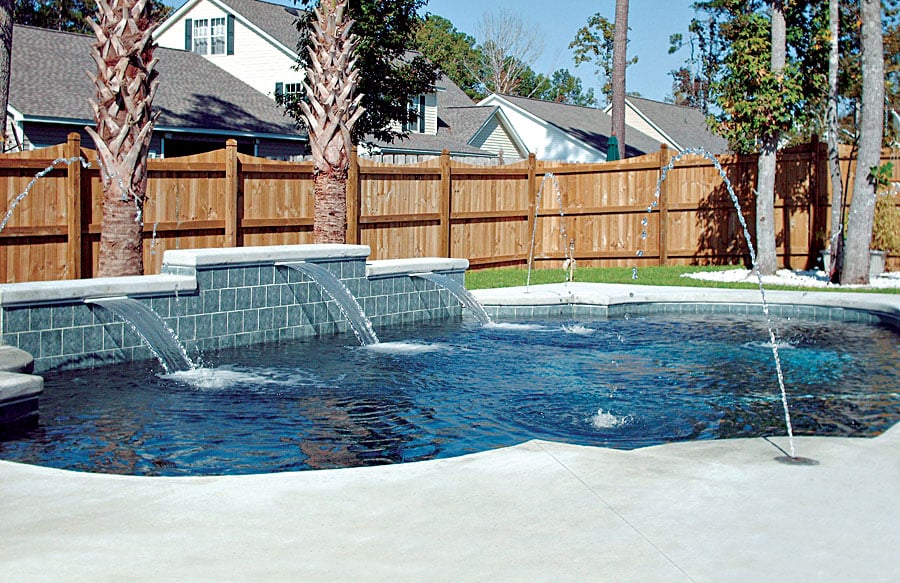
Exposing a spectrum of flaws
You may know that wearing dark colors may help you look thinner and more attractive. But on a pool, dark colors broadcast blemishes—amplifying every flaw in the pool’s surface coating.
And flaws happen. Swimming pool plaster problems are common; the surface in every pool ever built will have them at some point. Over time, plaster submerged in water in any pool is susceptible to a variety of nearly inevitable imperfections.
Imperfections come with the territory. To begin, you have the inherent nature of the material, which contains soluble mineral constituents.
Then pool plaster is continuously subjected to the dynamic influence of pool water and chemical and mineral elements.
The relationship between plaster and water is surprisingly complex. It has been the subject of decades of study and heated debate within the pool industry.
Issues that impact the appearance of the finish run the gamut. They include the exact ratio of raw materials used in the plaster mix, application techniques, weather conditions during application, curing times, and the manner in which the water was chemically treated when the pool was first filled during the start-up process.
Once in operation, your pool water’s mineral balance, sanitizer-chemical levels, and kind of chlorine you use impacts plaster condition and appearance.
All of these variables can and almost always will contribute to small imperfections and various forms of deterioration.
On a light-colored pool surface, many of these flaws and wear-and-tear developments are not particularly noticeable unless they are more severe or eventually become more pronounced.
However, like an automobile with dark paint, even minor issues are dramatically more visible in a black-bottom pool. Here is an overview of the kinds you could face.
Mineral Scale
When plaster is immersed in water, a variety of chemical processes occur that can wreak havoc. Among the most common is the build-up of mineral scale.
Most people are familiar with whitish calcium deposits that form on kitchen and bathroom surfaces. In a black-bottom pool, these deposits can form on—pardon the pun—a massive “scale.”
When they do, look out! Those invading deposits become annoyingly visible.
That’s right, all of sudden, your dark pool interior is riddled with random speckles, streaks, nodules, and other blemishes like it has some kind of cementitious disease.
Fading
Even if scale isn’t the problem, be on the lookout for another issue that’s unique to deep-colored finishes. The material’s appearance often fades unevenly and sometimes quickly.
Fading comes in swirling, mottled patterns of uneven, patchy color that form almost as quickly as the pool is filled.
Even worse: This blotchy fading often reveals once-nearly invisible trowel marks or even the footsteps of workers who walked across the freshly applied plaster. Compared to white or light blue plaster, these common blemishes are far more apparent on a dark background.
Erosion/Etching
Now, on the opposite end of the spectrum of scale build up, we have a loss of the finish. When calcium, alkalinity, and pH is too low, water falls out of balance and can become “aggressive.” When it does, the water will eat away at the plaster surface.
The result can be a host of general etching and “spot” etching damage that can badly mar your pool’s appearance.
If that’s not bad enough, etched plaster can produce two additional problems. The tiny pits and micro-fissures are rough to the touch.
Another “pitfall” is how they provide a ready home for swimming pool algae blooms where the opportunistic waterborne organisms find a safe haven to grow.
Even on a relatively smooth surface, certain kinds of algae can be difficult to remove. So cleaning the invading blooms from tiny, uneven recesses becomes a greater burden.
Application Realities
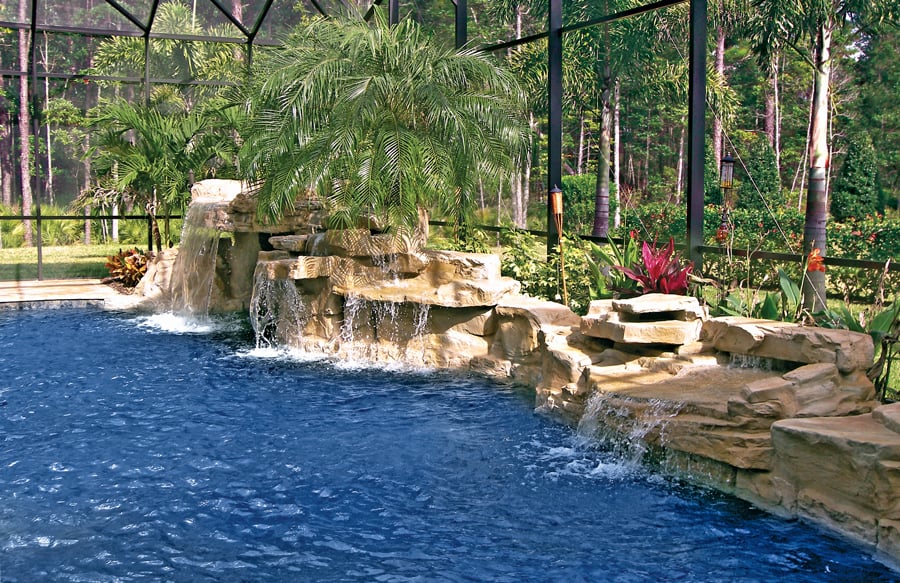
Even when mixed and troweled onto a pool by skilled tradesmen, plaster application is often a somewhat precarious process.
In some cases, homeowners can expect to face swimming pool construction delays from hot weather and humidity. These and other external conditions can also influence how the pool plaster turns out.
One reason is that fresh material is susceptible to external conditions such as wind, sunlight, humidity, and high temperatures. Each of these factors can negatively impact the plaster’s final texture during application and how it cures.
The other reason is that plaster application is quite simply, a fickle matter. The material and how it is troweled onto the gunite pool shell is vulnerable to anything less than perfect technique.
Small, workmanship-related realities routinely manifest in the formation of nodules, delamination, micro-cracking, and variations in color.
Many variables can lead to a range of imperfections. Among them: slightly improper mix design, the wrong water-to-cement ratio, contaminants in the mix, minor miscalculations in amounts of chemical accelerators during the application, and improper curing times.
With all of these potential problems and various causes, marred black bottom pools can become a source of dispute between pool owners and the pool builder or plastering contractor.
As a homeowner, you may seek some type of repair or replacement of an unsatisfactory finish. However, is the blemish actually poor workmanship or a routine imperfection? The question becomes is someone actually at fault or it’s a case of the plaster gremlins common in thousands of pools?
Plaster companies will deflect blame onto the service company or homeowner—claiming poor water chemistry. Service techs are likely to counter that the problems are due to workmanship—and it’s the builder or plaster company who is responsible.
You get the dark picture. Suffice it to say that frequently, black bottom pools become black holes of frustration.
Safety hazard?
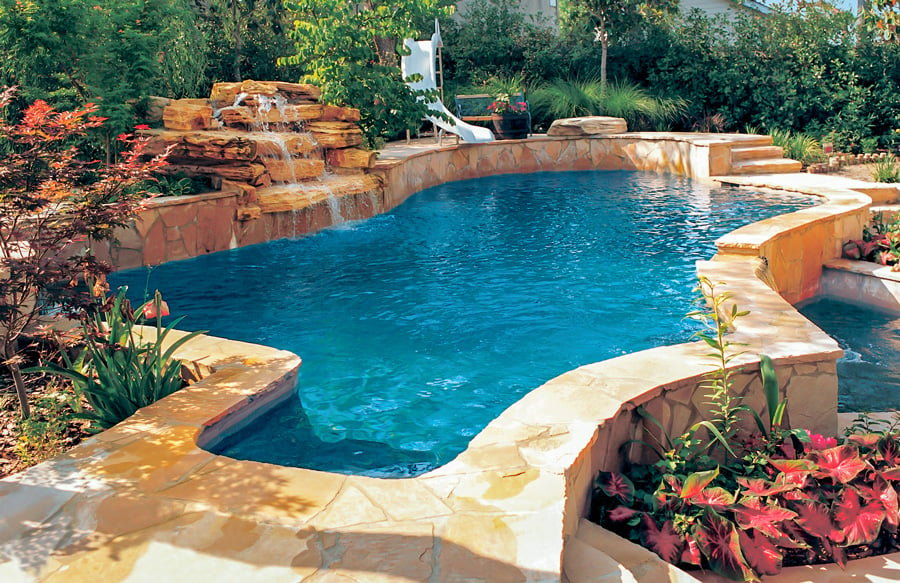
Safety is critical for any backyard swimming pool. Some experts raise concerns over the risks that come with a black-bottom pool. Can the deep color actually contribute to injuries?
The argument goes that the dark interior messes with a swimmer’s depth perception. Underwater, the walls and bottom of the pool may be closer than they appear.
As a result, in some cases, this phenomenon may make it easier to accidentally bang your hand, foot, or head against the pool shell.
The visual distortion can be more serious to someone jumping into the pool from the pool deck. With the dark walls and bottom, it can be hard to judge how deep the water is in some areas of the pool.
Someone may believe the water is deeper than it is—and therefore safe to jump in. They don’t realize the water may be only a few feet deep, and they could end up hurt by hitting the shallow pool bottom.
Beyond the norm: the risk of rarity
Now, an entirely other reason to avoid a black-bottom pool comes down to selling your home. Yep, your black-bottom beauty being a “rare bird” can become a negative in marketing your property.
Infrequently used dark colors in a pool produce a dramatic, moody body of water. But will everyone looking to buy a home with a pool feel the same? Should you ever sell your home, that atypical appearance may produce hesitancy among prospective buyers.
Here’s why: Most people are accustomed to seeing blue water in a pool. By reflecting the sky, the water appears blue when the interior finish is white, tan, light grey, or light blue.
So when a homebuyer views a dozen homes with a sparking-bright blue pool—and then comes upon your black-plastered project, the unusual appearance can be a turn-off.
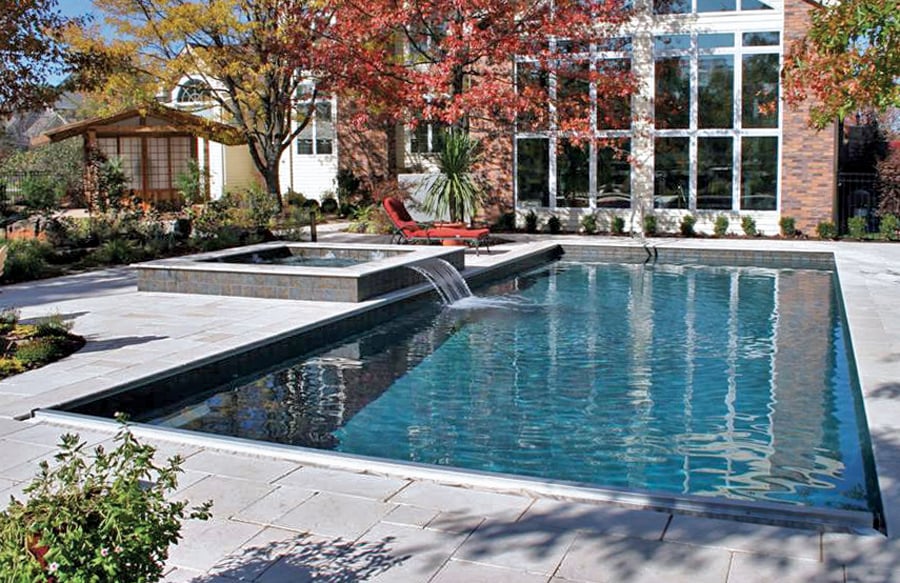
What to expect from your pool contractor
Are you still determined to go dark with your pool finish?
Whether you are building a new pool or remodeling an existing pool, if you opt for a dark grey or black plaster, be prepared.
First, you may receive some pushback. An experienced pool contractor might warn you about the frequent consequences of such a choice. You may hear them recite the litany of issues we have outlined above.
They might encourage you to reconsider. They may trot out plaster samples of other popular colors in whites, creams, tans, soft blues, greys, and greens.
If you still insist your willingness to roll the dice to go dark, don’t be surprised if they present you with a written waiver.
The dark-finish waiver will likely tick off a list of each and every potential peril, and it will require you to acknowledge in writing that you understand and accept each risk.
Your contractor will also advise that maintaining optimal chemical balance in your pool water—on a consistent basis—will be crucial for minimizing troublesome issues with your dark pool plaster.
The dark pebble option

Do you still really want a black-bottom pool?
The good news is there is an alternative solution. The answer is a pebble finish.
This kind of material features exposed aggregate of tiny natural pebbles. Pebble blends come in a variety of colors, including deep blue, dark grey, and black.
The final product is beautiful and most critically, far less susceptible to the registry of plaster woes outlined above. Pebble’s good look perform superbly, and in a properly maintained pool it will typically last 15 to 20 years.
A few downsides do come with pebble. In most markets, when comparing marcite plaster and quartz to pebble, the price for pebble runs significantly more.
Pebble surfaces also have a distinct bumpy texture. The feel may appeal to some homeowners, but others prefer the smooth touch of plaster or a color quartz finish. For a more even, somewhat smoother feel, some pebble blends use extremely small stones or ones that are more polished.
Be sure to discuss your preferences and the potential issues in depth with your pool builder. Do keep in mind that tens of thousands are pools are built with a typical white, cream, beige, or light blue finish—and the results are beautiful in any backyard.




.jpg?width=1490&name=rock-waterfall-slide-pool%20(1).jpg)